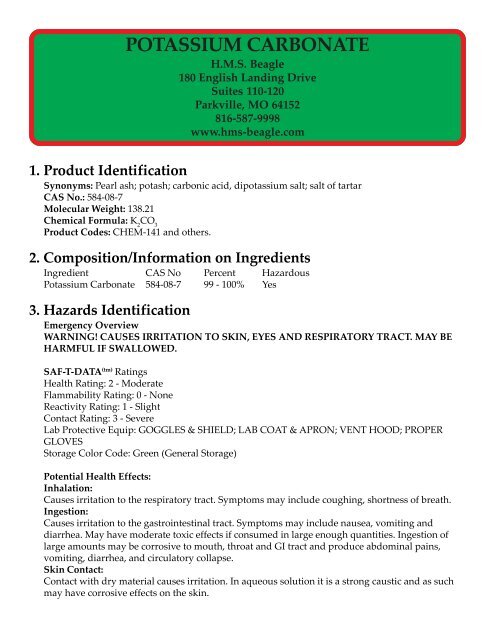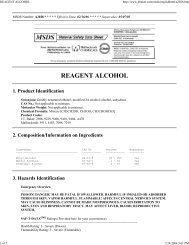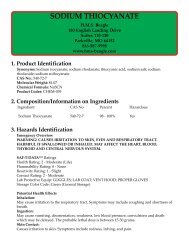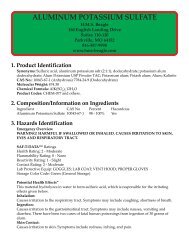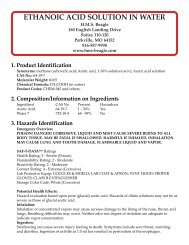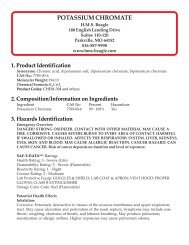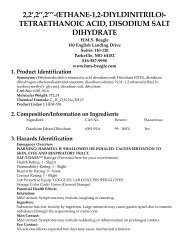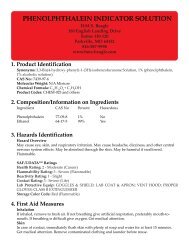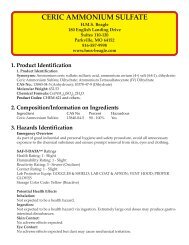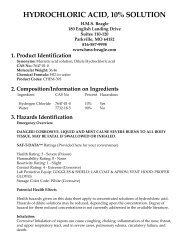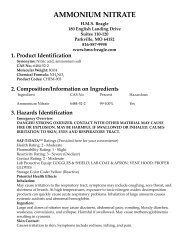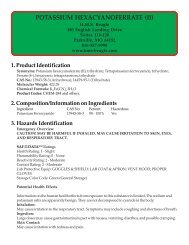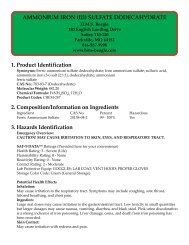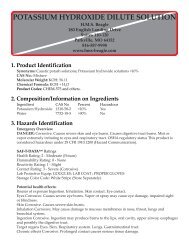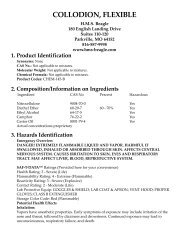POTASSIUM CARBONATE - HMS Beagle
POTASSIUM CARBONATE - HMS Beagle
POTASSIUM CARBONATE - HMS Beagle
You also want an ePaper? Increase the reach of your titles
YUMPU automatically turns print PDFs into web optimized ePapers that Google loves.
<strong>POTASSIUM</strong> <strong>CARBONATE</strong>H.M.S. <strong>Beagle</strong>180 English Landing DriveSuites 110-120Parkville, MO 64152816-587-9998www.hms-beagle.com1. Product IdentificationSynonyms: Pearl ash; potash; carbonic acid, dipotassium salt; salt of tartarCAS No.: 584-08-7Molecular Weight: 138.21Chemical Formula: K 2CO 3Product Codes: CHEM-141 and others.2. Composition/Information on IngredientsIngredient CAS No Percent HazardousPotassium Carbonate 584-08-7 99 - 100% Yes3. Hazards IdentificationEmergency OverviewWARNING! CAUSES IRRITATION TO SKIN, EYES AND RESPIRATORY TRACT. MAY BEHARMFUL IF SWALLOWED.SAF-T-DATA (tm) RatingsHealth Rating: 2 - ModerateFlammability Rating: 0 - NoneReactivity Rating: 1 - SlightContact Rating: 3 - SevereLab Protective Equip: GOGGLES & SHIELD; LAB COAT & APRON; VENT HOOD; PROPERGLOVESStorage Color Code: Green (General Storage)Potential Health Effects:Inhalation:Causes irritation to the respiratory tract. Symptoms may include coughing, shortness of breath.Ingestion:Causes irritation to the gastrointestinal tract. Symptoms may include nausea, vomiting anddiarrhea. May have moderate toxic effects if consumed in large enough quantities. Ingestion oflarge amounts may be corrosive to mouth, throat and GI tract and produce abdominal pains,vomiting, diarrhea, and circulatory collapse.Skin Contact:Contact with dry material causes irritation. In aqueous solution it is a strong caustic and as suchmay have corrosive effects on the skin.
Eye Contact:Causes extreme irritation, redness, pain and possibly corneal damage.Chronic Exposure:A chronic dermatitis may follow repeated contact with this substance.Aggravation of Pre-existing Conditions:No information found.4. First Aid MeasuresInhalation:Remove to fresh air. If not breathing, give artificial respiration. If breathing is difficult, giveoxygen. Get medical attention.Ingestion:If swallowed, DO NOT INDUCE VOMITING. Give large quantities of water. Never give anythingby mouth to an unconscious person. Get medical attention immediately.Skin Contact:Immediately flush skin with plenty of water for at least 15 minutes. Remove contaminatedclothing and shoes. Get medical attention. Wash clothing before reuse. Thoroughly clean shoesbefore reuse.Eye Contact:Immediately flush eyes with plenty of water for at least 15 minutes, lifting lower and uppereyelids occasionally. Get medical attention immediately.5. Fire Fighting MeasuresFire:Not considered to be a fire hazard.Explosion:Not considered to be an explosion hazard. An explosion occurred after mixing sodiumhydrosulfite, aluminum powder, potassium carbonate and benzaldehyde.Fire Extinguishing Media:Use any means suitable for extinguishing surrounding fire.Special Information:In the event of a fire, wear full protective clothing and NIOSH-approved self-contained breathingapparatus with full facepiece operated in the pressure demand or other positive pressure mode.6. Accidental Release MeasuresVentilate area of leak or spill. Wear appropriate personal protective equipment as specified inSection 8. Spills: Pick up and place in a suitable container for reclamation or disposal, using amethod that does not generate dust.7. Handling and StorageKeep in a tightly closed container, stored in a cool, dry, ventilated area. Protect against physicaldamage. Isolate from incompatible substances. Containers of this material may be hazardouswhen empty since they retain product residues (dust, solids); observe all warnings andprecautions listed for the product.
8. Exposure Controls/Personal ProtectionAirborne Exposure Limits:None established.Ventilation System:A system of local and/or general exhaust is recommended to keep employee exposures as low aspossible. Local exhaust ventilation is generally preferred because it can control the emissions ofthe contaminant at its source, preventing dispersion of it into the general work area. Please refer tothe ACGIH document, Industrial Ventilation, A Manual of Recommended Practices, most recentedition, for details.Personal Respirators (NIOSH Approved):For conditions of use where exposure to dust or mist is apparent and engineering controls are notfeasible, a particulate respirator (NIOSH type N95 or better filters) may be worn. If oil particles(e.g. lubricants, cutting fluids, glycerine, etc.) are present, use a NIOSH type R or P filter. Foremergencies or instances where the exposure levels are not known, use a full-face positivepressure,air-supplied respirator. WARNING: Air-purifying respirators do not protect workers inoxygen-deficient atmospheres.Skin Protection:Wear impervious protective clothing, including boots, gloves, lab coat, apron or coveralls, asappropriate, to prevent skin contact.Eye Protection:Use chemical safety goggles and/or full face shield where dusting or splashing of solutions ispossible. Maintain eye wash fountain and quick-drench facilities in work area.9. Physical and Chemical PropertiesAppearance:Fine white granules.Odor:Odorless.Solubility:Soluble in equal parts of cold water.Specific Gravity:2.29pH:11.6 Aqueous solution% Volatiles by volume @ 21°C (70°F):0Boiling Point:Decomposes.Melting Point:891°C (1636°F)Vapor Density (Air=1):No information found.Vapor Pressure (mm Hg):No information found.Evaporation Rate (BuAc=1):No information found.
10. Stability and ReactivityStability:Stable under ordinary conditions of use and storage.Hazardous Decomposition Products:Contact with acids and involvement in a fire can cause formation of carbon dioxide. Thermaldecomposition may also form potassium oxide.Hazardous Polymerization:Will not occur.Incompatibilities:Acids, chlorine trifluoride, magnesium. An explosion occurred after mixing sodium hydrosulfite,aluminum powder, potassium carbonate and benzaldehyde.Conditions to Avoid:Moisture, heat, dusting and incompatibles.11. Toxicological InformationOral rat LD50: 1870 mg/kg.Cancer ListsNTP CarcinogenIngredient Known Anticipated IARC CategoryPotassium Carbonate (584-08-7) No No None12. Ecological InformationEnvironmental Fate:No information found.Environmental Toxicity:No information found.13. Disposal ConsiderationsWhatever cannot be saved for recovery or recycling should be managed in an appropriate andapproved waste disposal facility. Processing, use or contamination of this product may change thewaste management options. State and local disposal regulations may differ from federal disposalregulations. Dispose of container and unused contents in accordance with federal, state and localrequirements.14. Transport InformationNot regulated.15. Regulatory InformationChemical Inventory Status - Part 1Ingredient TSCA EC Japan AustraliaPotassium Carbonate (584-08-7) Yes Yes Yes YesChemical Inventory Status - Part 2CanadaIngredient Korea DSL NDSL Phil.Potassium Carbonate (584-08-7) Yes Yes No Yes
Federal, State & International Regulations - Part 1SARA 302 SARA 313Ingredient RQ TPQ List Chemical Catg.Potassium Carbonate (584-08-7) No No No NoFederal, State & International Regulations - Part 2RCRA TSCAIngredient CERCLA 261.33 8(d)Potassium Carbonate (584-08-7) No No NoChemical Weapons Convention: No TSCA 12(b): No CDTA: NoSARA 311/312: Acute: Yes Chronic: No Fire: No Pressure: NoReactivity: No (Pure / Solid)Australian Hazchem Code: None allocated.Poison Schedule: None allocated.WHMIS:This MSDS has been prepared according to the hazard criteria of the Controlled ProductsRegulations (CPR) and the MSDS contains all of the information required by the CPR.16. Other InformationNFPA Ratings: Health: 2 Flammability: 0 Reactivity: 0Label Hazard Warning:WARNING! CAUSES IRRITATION TO SKIN, EYES AND RESPIRATORY TRACT. MAY BEHARMFUL IF SWALLOWED.Label Precautions:Avoid breathing dust.Avoid contact with eyes, skin and clothing.Keep container closed.Use only with adequate ventilation.Wash thoroughly after handling.Label First Aid:If swallowed, DO NOT INDUCE VOMITING. Give large quantities of water. Never give anythingby mouth to an unconscious person. If inhaled, remove to fresh air. If not breathing, give artificialrespiration. If breathing is difficult, give oxygen. In case of contact, immediately flush eyes or skinwith plenty of water for at least 15 minutes. Remove contaminated clothing and shoes. Washclothing before reuse. In all cases, get medical attentionProduct Use:Laboratory Reagent and Consumer Hobby.Revision Information:None
Disclaimer:************************************************************************************************H.M.S. <strong>Beagle</strong> and/or Rainbow House, LLC, provides the information contained herein in goodfaith but makes no representation as to its comprehensiveness or accuracy. This document isintended only as a guide to the appropriate precautionary handling of the material by aproperly trained person using this product. Individuals receiving the information must exercisetheir independent judgment in determining its appropriateness for a particular purpose.NEITHER H.M.S. BEAGLE NOR RAINBOW HOUSE, LLC MAKE NO REPRESENTATIONSOR WARRANTIES, EITHER EXPRESS OR IMPLIED, INCLUDING WITHOUT LIMITATIONANY WARRANTIES OF MERCHANTABILITY, FITNESS FOR A PARTICULAR PURPOSEWITH RESPECT TO THE INFORMATION SET FORTH HEREIN OR THE PRODUCT TOWHICH THE INFORMATION REFERS. ACCORDINGLY, H.M.S. BEAGLE AND RAINBOWHOUSE, LLC, WILL NOT BE RESPONSIBLE FOR DAMAGES RESULTING FROM USE OFOR RELIANCE UPON THIS INFORMATION.************************************************************************************************Prepared by: John Farrell KuhnsPhone Number: 816-587-9998 (U.S.A.)


